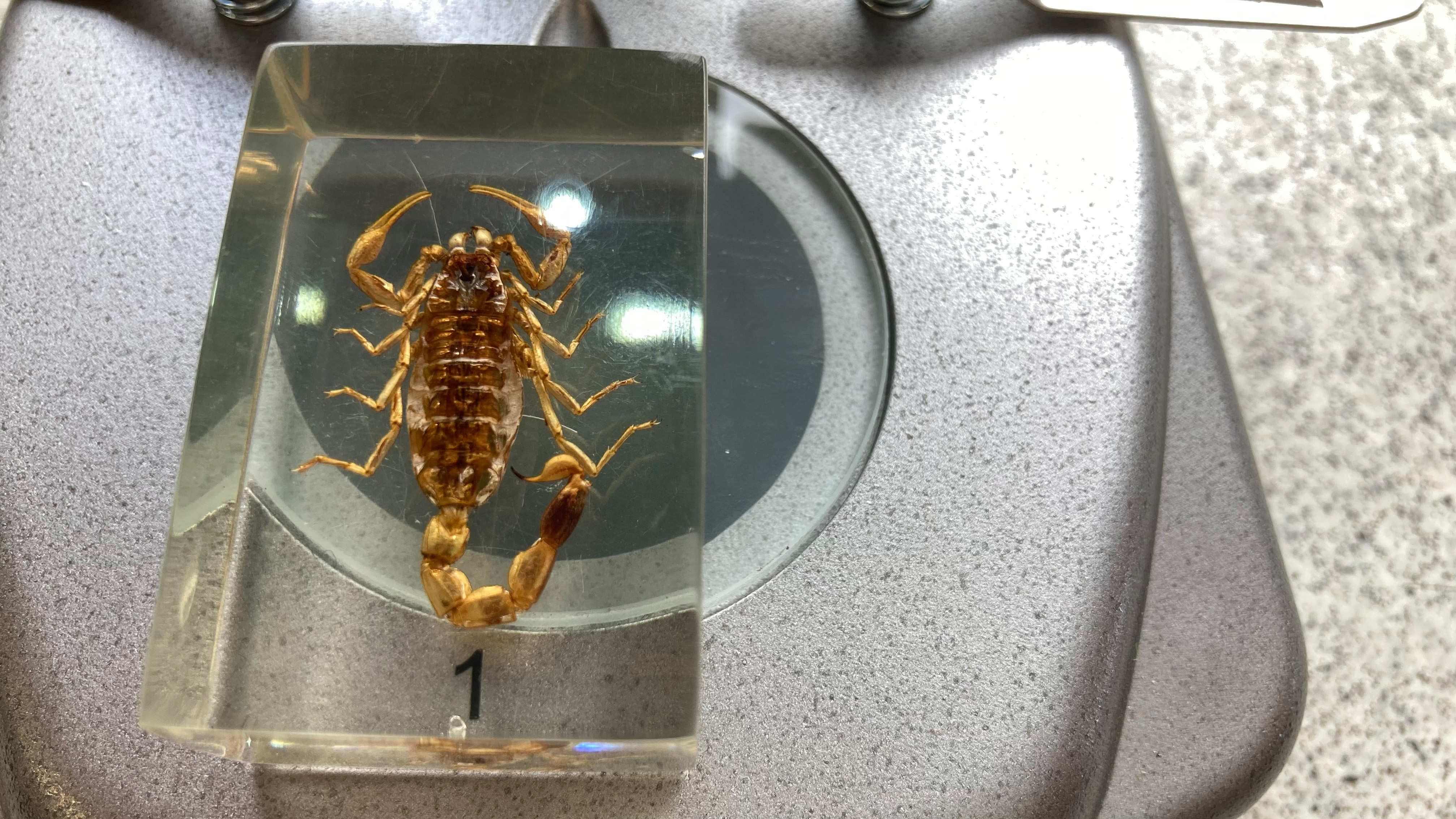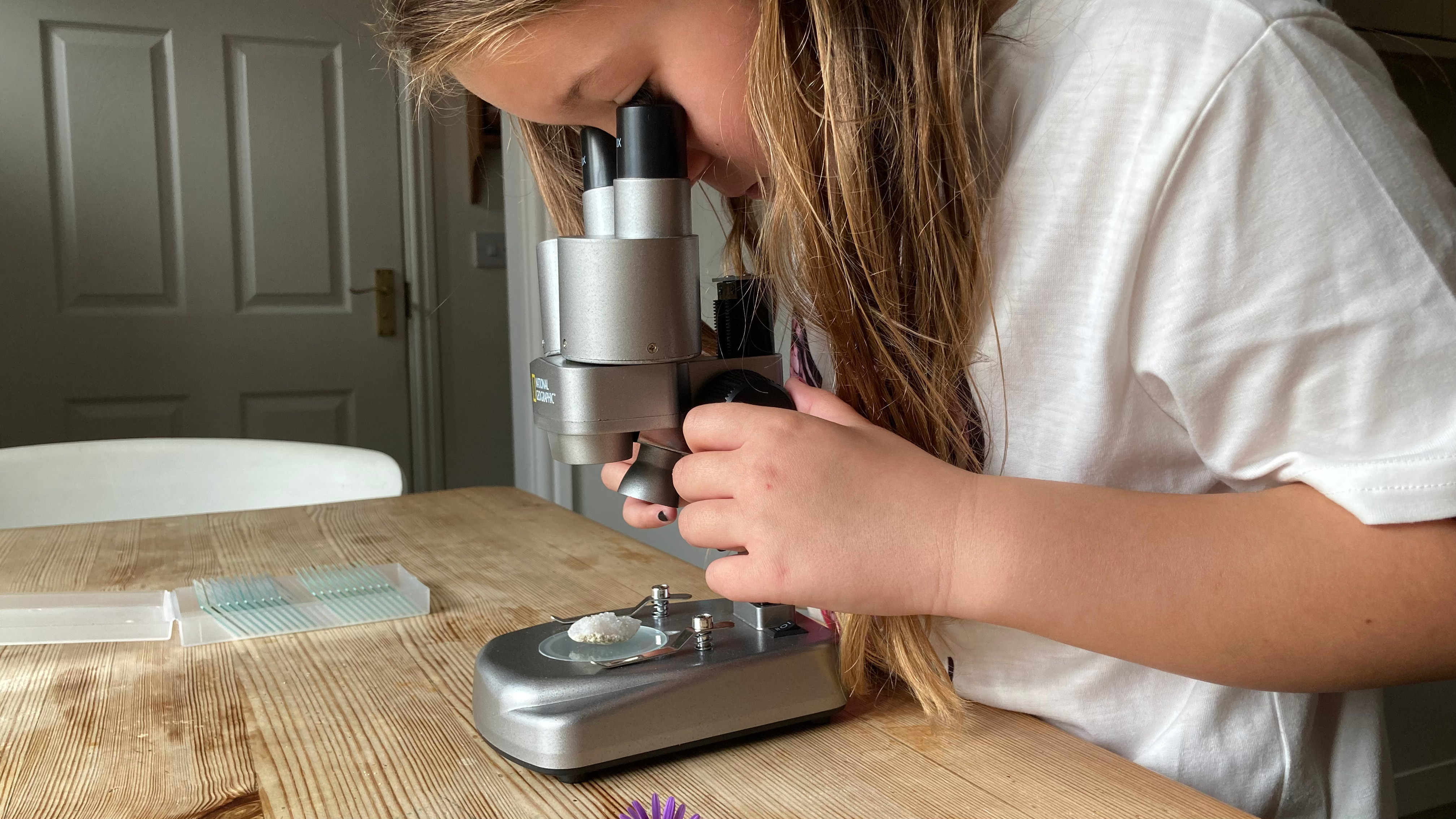Live Science Verdict
With prepared and blank slides, additional accessories and a choice of lighting, the National Geographic Ultimate Dual is a great all-in-one microscope kit for young biologists and geologists.
Pros
- +
Good for solid specimens
- +
Gives 3D images
- +
Numerous scientific accessories included
Cons
- -
Low magnification
- -
Adult help needed to set it up
- -
Batteries not included
Why you can trust Live Science
We had a mixture of experiences while reviewing the National Geographic Ultimate Dual. Stereo microscopes can be tricky to use, so it was a challenge for young novices to fathom. However, what started off as quite a frustrating experience went on to give a wealth of excitement, adventure and discovery. This microscope kit has the right balance of education and fun to provide kids with engaging tasks that they can carry out independently.
The name of this microscope, Ultimate Dual, describes the two different LED placements, upper and lower. But it could also be a nod to its multitude of paired functions: for solid and transparent objects, lab and outdoor use, living and non-living specimens, or because of the two separate images needed for stereo 3D viewing.
The activities possible with the National Geographic Ultimate Dual stereo microscope kit are numerous and varied and will give children a good introduction to the world of microscopy.
Kids who are a little older might benefit from one of the best microscopes for students, while younger children who are just getting interested in science will love the best microscopes for kids.
National Geographic Ultimate Dual Stereo Microscope review
National Geographic Ultimate Dual Stereo Microscope: Design

- Attractive as a gift
- Scientific accessories kit
- Ideal for younger children
The National Geographic Ultimate Dual Stereo Microscope has been designed as a complete, versatile starter kit for children. By layering two separate images, one from each of the binocular tubes, its stereo design creates a three-dimensional image.
The lower LED allows light to be shone through specimens, which is ideal for translucent or very thin objects, especially slides of cells and tissues. The upper LED shines onto solid objects from above and allows their shape and texture to be visualized. With multiple accessories, we found that this design has hit the right balance between being fun and educational, having almost everything needed to provide hours of 3D exploring.
Designed as a gift, the outer packaging is attractive. The box is glossy yet textured, coupled with some enticing images that give this product shelf appeal and make you want to delve inside. Children enjoyed finding multiple packages within: this created excitement and added to the unwrapping pleasure. Adults enjoyed the complete package concept so that no extra components were necessary. But it was frustrating that the microscope needed batteries, which were not supplied. It would have been useful if this information was printed on the box — we could have been more prepared. There is nothing worse than a gift that cannot be immediately enjoyed!

We were pleased that the accessories included were convincingly “scientific.” Having a pipette and tweezers to transfer solids and liquids made the whole experience more realistic. The petri dish was also brilliant for holding pond water, rather than having to prepare slides. The accessories enabled instant gratification in the form of prepared slides and the rock sample. Yet both prompted further investigation through scientific enquiry.
Blank slides were included, for the preparation of children’s own slides. Seeing the form and textures of the rock stimulated the kids’ imaginations and they were soon on the hunt for feathers, shells, moss, seeds and flowers to put under scrutiny. Although we were unsuccessful in hatching any brine shrimp, we could see the benefit in getting kids to gain experience in following a method and patiently awaiting the results.


Head: Adjustable stereo with 10X and 25X eyepiece lenses
Magnification: 20X or 50X
Light source: Dual, bottom and upper LEDs
Focusing: Coarse focusing only
Power: Two AA batteries
Ready for use?: No. Needs two AA batteries
Slide accessories: Prepared and blank slides, cover slips and box
Extras: Pipette, tweezers, brine shrimp eggs and hatchery, petri dish, booklet
Add-ons: National Geographic 200-piece rocks, crystals, fossils and gemstones set, National Geographic break-open geodes
Another nice touch was the educational booklet. Not only did it contain information about how to use the microscope, there was also a section on the history of the microscope and suggestions for experiments that could be carried out using it. Sadly, the booklet contained several errors (we identified three with just a quick scan). The most obvious was in a duplicated illustration title — three different images asked, "What are fossils?" but this was relevant to only one of them.
Designed with younger children in mind, there were a number of features that made the Ultimate Dual a safer product. Powered entirely by batteries, kids would not need to plug it into the mains electricity. Additionally, although still made of glass, we noticed that the corners of the slides had been rounded off, minimizing the chance of cuts. The microscope was also light, so it could be carried easily.

Unfortunately, we identified one hazard that does need addressing. The glass cover above the lower LED is not fixed in position. When turning the microscope upside down to insert the batteries, the glass fell out. This could have broken and been a cutting hazard. It also exposed the bulb beneath. Moreover, the eyepiece lenses fell out as well!
National Geographic Ultimate Dual Stereo Microscope: Performance

- Great for 3D viewing, once binoculars are set up correctly
- Good for solid objects
- Low magnification is not ideal for cell microscopy
When judging the performance of the National Geographic Ultimate Dual stereo microscope it is important to recognize that, although we found the performance poor when observing cells, this microscope was a brilliant tool for magnifying solid objects and seeing their three-dimensional structure and surface textures.
If your primary use for a microscope is to observe cells, the Ultimate Dual is probably not the right choice for you. There are more robust, higher-quality microscopes available with a much higher magnification. The highest magnification is achieved when using the 25X eyepieces. The overall magnification becomes 50X, because of the 2X objective lens. However, this is the equivalent of the minimum magnification on other, similarly priced compound microscopes. Cells need to be greatly enlarged to observe the structures within them. Ergo, the Ultimate Dual falls short in this area.


Fortunately, the viewing of solid objects in 3D is where the National Geographic Ultimate Dual shines. Although tricky to set up initially, once the binocular distance is correctly set up for the viewer, specimens can be swapped and interchanged with ease.
Objects observed in stereo have a surreal quality. The image pops out towards you and can give the effect of floating as you move your head. This can feel a little strange, but it is also really exciting, especially with larger objects like whole insects, shells and rocks. Although fiddly, it was worth persevering with as the thrilling 3D imagery was new to the children — even those who had used a microscope before.



A further benefit of the Ultimate Dual is that the top LED illuminates objects from above, bouncing light from the surface up through the phototubes. This is what makes observing solid objects possible. As the light reflects, color and texture are retained. Beautiful patterns were seen on flowers, butterfly wings and feathers. The Ultimate Dual was used in this way to dissect flowers and examine water from the pond.
Pond water was pipetted into the petri dish and inspected with the top light. Some small creatures were enlarged to 50X magnification. However, 25X magnification was more useful here so that a wider field of view could capture more activity. Flowers were dissected with tweezers, to remove the stamen and petals and in some cases expose the seeds within the ovaries. Although small, all the accessories performed well during our investigations.

In summary, the National Geographic Ultimate Dual Stereo Microscope performed brilliantly when viewing solid specimens in 3D, but poorly when magnifying most cells. However, the younger children who would enjoy using this tool to magnify objects of interest around their house and garden probably haven’t begun learning about the structure of cells yet anyway. So in reality, this may not be a huge problem at all.
National Geographic Ultimate Dual Stereo Microscope: Functionality


- Capable of viewing solid objects in 3D
- Deep viewing platform for larger objects
- Choice of eyepiece lenses
The National Geographic Ultimate Dual had four different functions that needed to be set up correctly before being rewarded with an image. But once explained and demonstrated, children could confidently and independently switch between specimens and let their imaginations and wonder take over.
Our youngest participant was 7 years old. After following instructions a few times, she became impressively competent in adjusting her binoculars, selecting the correct LED, moving her specimen into view and focusing.
The most complicated maneuver was to place the binocular eyepieces at the optimum distance so that the two separate images became layered on top of one another, which is essential for stereo 3D viewing. This measurement is different for each observer. Therefore, binocular placement cannot be set up by an adult as the interpupillary distance will not match the child’s. We found that the best technique for this was to get the child to look through the eyepieces, without a specimen, with the lower LED on. Ask them to bring the phototubes together until they see just one circle, and the machine is then ready to be used.


Unfortunately, this interfered with the teaching process somewhat, as shared viewing required binocular adjustment for every new viewer. We compromised by leaving the binoculars set to the child's interpupillary distance and viewing through one eyepiece only. We weren’t seeing the 3D image but were able to join in the excitement.
One function that we particularly enjoyed was having the stage in a permanent position with the eyepieces moving up and down while focusing. Keeping the specimens still enabled us to select reasonably large objects. The fixed stage was ideal for supporting a huge moth in order to magnify the tip of its wing without damaging it.


The stage-to-objective lens distance was also relatively large, giving us enough room to observe taller objects. We had resin-mounted invertebrates — crabs and a scorpion — as well as shells and rocks. We also had enough room to place our hands under the microscope, to scrutinize all the nooks and crannies in our skin and nails.
The Ultimate Dual, as its name suggests, benefits from having two different light sources. The upper and lower LEDs can be changed instantly, at the flick of a switch. Children did this with ease and quickly learned what was necessary for each scenario: upper LED for solid objects, and lower LED for translucent sections of tissues and organisms on slides. Sadly, the brightness on the LEDs was not adjustable, meaning some samples were too bright, and others too dark.
To conclude, although there were a number of functions to get right, the children we introduced to it were enthusiastic, quick to learn and proud to show how capable and independent they were. We would recommend the National Geographic Ultimate Dual stereo microscope as a gift for younger family members or friends, as long as you have time to help get them started on their microscopic journey.
Should you buy the National Geographic Ultimate Dual Stereo Microscope?
✅ You want to observe specimens in 3D: The Ultimate Dual is a stereo microscope. Seeing two separate, layered images gives them depth and texture.
✅ You want a basic starter kit: The accessories supplied will give young children a taste of being a scientist.
❌ One eye doesn’t work effectively: Stereo images rely on visual information from both eyes.
❌ You need high magnification: The low-power magnification may be frustrating when viewing cells.
This would be a good gift for children who are curious about the world around them, as long as you are prepared to spend some time getting them used to the stereo function. It can be tricky to line up separate images, especially when viewing flat objects like cell slides. However, once mastered, the 3D imagery that can be observed is awesome.
Kids will find the details and textures of familiar objects and creatures fascinating. Additionally, the accessories allow children to delve into the world of being a scientist as they practice techniques such as dissecting, pipetting and mounting.
This stereo microscope sits at the more expensive end of the scale for the functions it provides. But you do get an attractively packaged and presented item — important in a gift — as well as the credibility that comes with the National Geographic name.



If this product isn't for you
For higher magnification, National Geographic makes a monocular microscope with 400X magnification: the National Geographic STEM kit for kids
For more ambitious children, National Geographic makes an entry-level microscope with 800X magnification and a smartphone holder
How we test
During a neighborhood science afternoon, kids were given free rein with an abundance of 3D objects to view, including vintage invertebrates, resin-mounted invertebrates, flowers, seeds, prepared slides, shells, moss, coins and rocks. Children were guided to use the petri dish and tweezers to handle their specimens and were encouraged to prepare some simple slides of their own. Later, children explored the gardens to find other interesting living and non-living things to examine.
In preparation for the science afternoon, we attempted to raise some brine shrimp from the supplied eggs, using the hatchery. Sadly we were unsuccessful, and despite our best efforts, the eggs didn't hatch. Fortunately, because of its portability, we were able to demonstrate the live-viewing capability of the National Geographic Ultimate Dual by observing mini-organisms from the pond instead.

Heather Barker is Head of Science at All Hallows Prep-School in Somerset, England. She has been educating young people between the ages of 5 and 19, as a teacher and private tutor, since 2012. Initially studying graphics with illustration to keep herself mentally challenged while bringing up her family, Heather re-trained by undertaking a Science degree with the Open University. Then, completed a Master’s degree in Developmental Biology and Biochemistry at The University of Bath in 2010. Afterward, Heather started work at the university as a Research Assistant, using histology and genetics to study the evolution of sticklebacks, before qualifying as a teacher in the Graduate training program.











